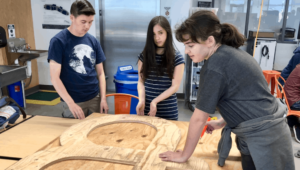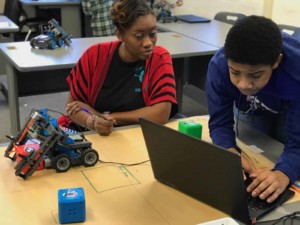Design Thinking for Human Resources
Productive systems are the result of productive designs. I spent the day at IDEO San Francisco yesterday helping to design systems to improve the quality schools in the worlds poorest neighborhoods. IDEA is a really cool environment and their process strategies help groups create productive and inspiring designs. Tim Brown, IDEO CEO, described the toolset and mindset in Change by Design: How Design Thinking Transforms Organization and Inspires Innovation.
Today I’m visiting with the Cristo Rey network in Kansas City. A great example of design thinking, the Cristo Rey school model incorporates a work study that provides powerful internship experiences for low-income students and corporate sponsorships that helps to subsidize tuition. Here’s an overview of the network:
The Cristo Rey Network is comprised of 24 high schools that provide a quality, Catholic, college preparatory education to young people who live in urban communities with limited educational options. Today we are educating 6,500 students, and will soon be reaching more than 10,000 young people, who otherwise would not have access to a quality, college preparatory education. This past year, 100% of the schools’ senior class was accepted into college. Our mission is clear – college success for Cristo Rey Network students.
These and other meetings caused me to think about the complicated process to recruiting and developing teachers and more broadly school staffs. There are at least 20 dimensions of an effective education human resource system. Here’s a list of some of the key questions to be answered:
1.Human capital philosophy: how do you express the importance of talent and consistently high execution to student outcomes? What variables are considered to be key to high performance?
2.Staffing strategy: how responsibilities divided between district/network and school? What is the decision-making process and parameters by position?
3.Compensation strategy: is paying competitive salaries important? Are hiring or performance incentives used? What part do benefits play in total compensation?
4.School staffing models: how are master teachers leveraged? Can personal digital learning leverage staffing patterns? Where is it necessary to use remote staff?
5.Career ladder: does a tiered staffing structure offer advancement opportunities for effective teachers and staff members? Can effective staff members take on additional responsibilities?
6.Job requirements definition: how are key success characteristics defined for each job (or job cluster)?
7.Recruiting: how do potential applicants learn about open positions? How are groups of top performers encouraged to apply? When and how are external recruiting partners utilized?
8.Screening: What kind of screen is used to review job applicants? What is the process and who is involved?
9.Interviewing: what is the interview process and who is involved? How are candidates required to demonstrate competence?
10. Diversity: are there specific efforts to hire and retain a diverse workforce? What protections are in place against bias and discrimination?
11. Orientation: after a candidate is hired, how are the on-boarded? Do they have an assigned mentor? What training is required? What online employment resources are available? How is the initial assignment made?
12. Job specific resources: if there a school/district curriculum with suggested lessons and pacing guides? How much latitude does a teacher have to create lessons and incorporate instructional materials? For classified roles, how do people know what to do and how to do it? What tools/equipment are provided for each position? What rules exist about personal equipment use?
13. Development: what formal/informal required/optional opportunities exist for staff development? Is there time in the schedule for teachers to collaborate horizontally and vertically?
14. Evaluation: in what ways do staff members receive frequent performance feedback? How are annual performance evaluations conducted? In what ways do evaluations influence compensation and career trajectory?
15. Culture: is there an intentional effort to create positive working conditions? How is the desired culture described?
16. Conditions: what agreements exist about working conditions, where and how flexibility is granted on an individual basis, and how agreements updated?
17. Decision making: how are staff members involved in site decision making? Are whistle-blowing provisions in place.
18. Physical environment: what is the desired physical setting? Are working conditions pleasant and productive? How do facilities problems get resolved?
19. Compensation and benefits administration: is comp & benefits administered internally or externally? Can staff satisfaction be improved? Can administration costs be reduced? Do HR systems provide analytical tools for trend analysis and problem identification?
20. Leadership: what process ensures that every site has effective and ethical leadership?
When approaching a complex systems problem like this, Tim Brown suggests insight, observation, and empathy:
- Insight: learning from the lives of others
- Observation: watching what people don’t do, listening to what they don’t say
- Empathy: standing in the shoes of others
Brown encourages active experimentation, “a judicious blend of bottom-up experimentation and guidance from above.” Some of the rules that apply to this approach include:
- The best ideas emerge when the whole system as room to experiment
- Those most exposed to changing externalities are the ones best placed to respond and most motivated to do so
- Ideas should not be favored based on who creates them
- Ideas that create buzz should be favored
- Gardening skills should be used to tend, prune, and harvest ideas
There are no point solutions to ‘teacher effectiveness.’ It is the result of a complex system designed intentionally to attract, retain, and develop talented and mission-focused teams. Read Tim’s book, get the Post-it notes out, and engage folks in design thinking.





0 Comments
Leave a Comment
Your email address will not be published. All fields are required.